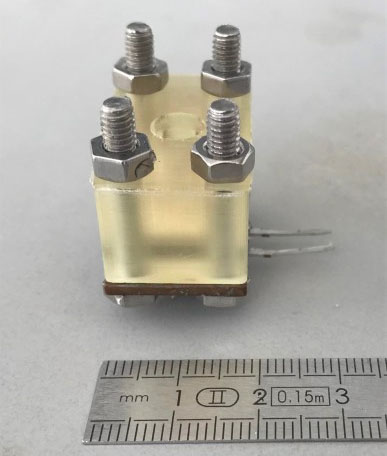| Apr 13, 2022 |
Nanoparticles could enable a more sensitive and durable rapid COVID-19 test
(Nanowerk News) Rapid antigen tests can quickly and conveniently tell a person that they are positive for COVID-19. However, because antibody-based tests aren’t very sensitive, they can fail to detect early infections with low viral loads.
|
|
Now, researchers reporting in ACS Sensors ("Molecularly Imprinted Polymer Nanoparticles Enable Rapid, Reliable, and Robust Point-of-Care Thermal Detection of SARS-CoV-2") have developed a rapid test that uses molecularly imprinted polymer nanoparticles, rather than antibodies, to detect SARS-CoV-2. The new test is more sensitive and works under more extreme conditions than antibody-based tests.
|
 |
| A 3D-printed device detects temperature changes when SARS-CoV-2 binds to molecularly imprinted polymer nanoparticles (ruler shows cm). (© ACS Sensors)
|
|
The gold standard test for COVID-19 diagnosis remains the reverse transcription-polymerase chain reaction (RT-PCR). Although this test is highly sensitive and specific, it generally takes 1-2 days to get a result, is expensive and requires special lab equipment and trained personnel.
|
|
In contrast, rapid antigen tests are fast (15-30 minutes), and people can take them at home with no training. However, they lack sensitivity, which sometimes results in false negatives. Also, the tests use antibodies against SARS-CoV-2 for detection, which can’t withstand wide ranges of temperature and pH.
|
|
Marloes Peeters and Jake McClements at Newcastle University, Francesco Canfarotta at MIP Diagnostics, and colleagues wanted to make a low-cost, rapid, robust and highly sensitive COVID-19 test that uses molecularly imprinted polymer nanoparticles (nanoMIPs) instead of antibodies.
|
|
The researchers produced nanoMIPs against a small fragment, or peptide, of the SARS-CoV-2 spike protein by creating molecular imprints, or molds, in the nanoparticles. These nanoscale binding cavities had a suitable size and shape to recognize and bind the imprinted peptide and, therefore, the entire protein. They attached the nanoparticles that bound most strongly to the peptide to printed electrodes.
|
|
After showing that the nanoMIPs could bind SARS-CoV-2, they developed a 3D-printed prototype device that detects binding of the virus by measuring changes in temperature.
|
|
When the team added samples from seven patient nasopharyngeal swabs to the device, the liquid flowed over the electrode, and the researchers detected a change in temperature for samples that had previously tested positive for COVID-19 by RT-PCR.
|
|
The test required only 15 minutes, and preliminary results indicated that it could detect a 6,000-times lower amount of SARS-CoV-2 than a commercial rapid antigen test. Unlike antibodies, the nanoMIPs withstood warm temperatures — which could give the test a longer shelf life in hot climates — and acidic pH — which might make it useful for monitoring SARS-CoV-2 in wastewater and saliva samples.
|
|
However, to prove that the test has a lower false negative rate than existing rapid antigen tests, it must be tested on many more patient samples, the researchers say.
|

